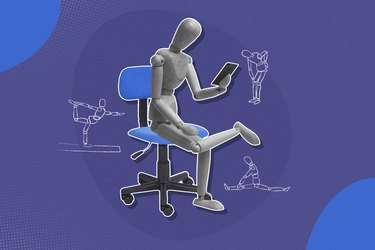
Despite all the hours you spend hunched over your iPhone texting, you probably don't think too much about your posture. You're not alone: Less than half of all Americans report being concerned about it, according to an October 2019 survey published by Florida health care network Orlando Health.
But the reality is that poor posture can lead to everything from chronic neck, back and even foot pain to trouble breathing and tummy troubles, says Nathaniel Melendez, ACSM, an exercise physiologist at the Orlando Health National Training Center. Here's a head-to-toe guide.
Video of the Day
Video of the Day
Related Reading
Your Head and Neck
Poor posture strains the muscles at the back of your head. This puts pressure on nearby nerves, triggering a head-splitter, says Sherry McAllister, DC, a chiropractor in San Jose, California.
But your noggin' isn't the only upper extremity hurting. A study published November 2014 in Surgical Technology International on text neck — a problem caused by constantly looking down at your phone or tablet — found that for every inch you tilt your head forward, the amount of weight it places on the tip of your spine nearly doubles. (When you hold your head in line with your shoulders, it only weighs about 10 pounds. Now move it forward an inch, and it's 20 pounds. Another inch, it's 40. You get the gist.) "Your neck takes the brunt of it," McAllister explains.
"Your joints and muscles are working harder than usual to compensate for your poor posture, so you expend more energy and tire more easily."
Your Jaw
A forward head posture puts strain on the muscles around your temporomandibular joint (TMJ), which can lead to pain and trouble opening your jaw.
Want proof? A January 2018 study published in the Journal of Physical Therapy Science found that correcting posture helped resolve TMJ pain.

Your Circulation
Poor posture affects your body's circulatory system by putting pressure on blood vessels, says Melendez. As a result, blood can't circulate as freely around your body, which can lead to feelings of low energy and fatigue.
It can also just make you feel pooped in general: "Your joints and muscles are working harder than usual to compensate for your poor posture, so you expend more energy and tire more easily," he explains.
Your Shoulders
Poor posture pinches the tendons in your rotator cuff, the group of muscles and tendons that connect your upper arm to your shoulder, a condition that's known as shoulder impingement, says McAllister. If it's left untreated, it can lead to an actual tear that can cause severe pain and weakness in the affected shoulder.
A December 2017 study published in the International Journal of Sports and Physical Therapy found that people with shoulder impingement were significantly more likely to have poor posture than those without the condition.

Your Back
A healthy back has three natural curves: an inward curve at your neck, an outward curve at your upper back and an inward curve on your lower back, says orthopedic surgeon Stephen Liu, MD, chairman and CEO of activewear company IFGFit . When you sit or stand up straight, you help keep the shape of these curves. But if you slouch, the muscles around these curves are stressed, which can trigger pain.
If you have weak abdominal muscles — and let's face it, many of us do — then the problem becomes even worse, since they can't take some of the slack. Instead, all the pressure — and pain — is focused around your spine.
A study published in April 2018 in BMC Musculoskeletal Disorders of over 500 people with chronic spine or shoulder pain found that when they automatically straightened up, they found their symptoms improved.
Your Breathing
Poor posture — especially when you're sitting down — compresses your chest area, which means your diaphragm can't open fully when you're breathing, says Dr. Liu.
Indeed, a January 2016 study published in the Journal of Physical Therapy Science found that poor posture — specifically, a forward head posture, or slouching forward — affected breathing by reducing lung capacity.
The result? You're not getting the oxygen you need, leaving you feeling fatigued and tired as a result.
Related Reading
Your Digestive System
If you slouch after a meal, it can trigger heartburn, since it can cause stomach acid to squirt in the wrong direction up your esophagus.
"The blood vessels in your GI tract also crush together, which in turn can slow down digestion," explains Liu.
Your Lower Body
When you slouch, you're leaning forward and walking slightly bent over, which can lead to knee pain, says McAllister.
Here's why: It causes strain on your joints, including poor hip alignment, which in turn can prevent your kneecap from sliding smoothly over your femur, or thighbone. It can also throw foot and ankle alignment off, which can lead to conditions like plantar fasciitis, where the thick band of tissue that connects your heel to the ball of your foot becomes inflamed.

How to Fix Bad Posture
Sit the right way. When you're sitting, it's important to keep your feet on the floor at all times, says Melendez. Your knees should be at or below hip level, your forearms parallel to the ground. If you're having trouble keeping this position, make sure you sit in a chair with a good backrest, to support your low and mid back and keep you in proper position.
Related Reading
Lighten your load. Anything you carry — whether it's a purse, backpack or even a small child — should not exceed more than 10 percent of your body weight, McAllister says. Otherwise, it's too much pressure on your upper back, which can affect your posture. If you're carting around something heavier, opt for a wheeled backpack or case, or make your kid ride in a stroller. If you do need to carry something very heavy for a short period, hold it close to your body rather than further out in your arms.
Break it up. When you're at work, the hours spent at your desk and computer can take a toll on your posture. The American Council on Exercise recommends breaking your workday up with a few back-strengthening exercises. Two to try:
- Scapular wall-slides: Stand with your feet hip- to shoulder-width apart in a quarter squat, your back and head pressed flat against a wall. Place your arms as close to the wall as possible at a 90-degree angle. Slide your arms directly up the wall, return to center, then slide your arms directly down the wall. Tuck your chin throughout to prevent shrugging. Repeat 10 times.
- External shoulder rotations: Stand with your feet hip- to shoulder-width apart, your elbows against the sides of your body and your arms at a 90-degree angle. Now slowly rotate both shoulders, keeping your elbows along the sides of your body and squeezing your shoulder blades toward each other. Return to the starting position and repeat 10 times.
Keep everything accessible. When working at a computer, the Mayo Clinic recommends that the top of the screen should be at eye level. Your computer mouse should be easily reachable and on the same surface as your keyboard. When typing, keep your wrists straight and your upper arms close to your body, your hands at elbow level. When talking on the phone, try to use your headset or speaker phone as much as possible rather than cradling the phone against your shoulder.
Strengthen your core. Focus on core exercises that strengthen abdominal and lower back muscles, says Eric Robertson, PT, DPT, spokesperson for the American Physical Therapy Association. These muscles connect to your spine and pelvis, so they're essential to ensuring you can stand up straight. Two easy moves to do every day:
- Planks: This classic move strengthens all your abdominal, shoulder and back muscles. Position yourself facedown with your toes and forearms on the floor and elbows at 90-degree angles. Tighten your abdominal and gluteal muscles and lift your body off the floor. Keep your back straight and hold for 30 to 45 seconds. Repeat two times.
- Back extensions: These strengthen your erector spinae, the back muscles that extend your spine and prevent slouching. Lie facedown on your stomach with legs straight behind you, elbows bent, hands and hips on the floor. Lift your head and shoulders with your forearms for five seconds. Repeat 12 to 15 times.
Try tai chi or yoga. Both can both help to open up the chest and upper back, countering the effects of hunching forward during daily activities. "Sun salutations are particularly great because they take you through the entire range of motion," says Robertson. Focus on poses like mountain pose, raised arm pose and upward- and downward-facing dog.
Sleep strategically. Posture's important when you're sleeping, too. The American Chiropractic Association recommends keeping your body in as neutral a position as possible. If you sleep on your back, put one pillow under the nape of your neck and another under your knees. If you're a side sleeper, sleep with enough pillows to keep your neck straight in line with your body and place a pillow between your legs. Try not to sleep on your tummy, which throws your whole body out of alignment.
- Orlando Health: "Reversing Pain and Health Issues May be as Simple as Fixing Your Posture"
- Surgical Technology International: "Assessment of stresses in the cervical spine caused by posture and position of the head."
- Journal of Physical Therapy Science: "Resolution of temporomandibular joint dysfunction (TMJD) by correcting a lateral head translation posture following previous failed traditional chiropractic therapy: a CBP® case report"
- International Journal of Sports Physical Therapy: "POSTURAL ALTERATIONS IN PATIENTS WITH SUBACROMIAL IMPINGEMENT SYNDROME"
- BMC Musculoskeletal Disorders:"Postural awareness and its relation to pain: validation of an innovative instrument measuring awareness of body posture in patients with chronic pain"
- Journal of Physical Therapy Science: "Effects of forward head posture on forced vital capacity and respiratory muscles activity."
- American Council on Exercise: "Five Ways to Improve Posture & Mobility at the Office"
- American Chiropractic Association: "Maintaining Good Posture."
Is this an emergency? If you are experiencing serious medical symptoms, please see the National Library of Medicine’s list of signs you need emergency medical attention or call 911.
